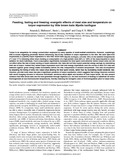| dc.contributor.author | Matheson, Amanda L. | |
| dc.contributor.author | Campbell, Kevin L. | |
| dc.contributor.author | Willis, Craig K. R. | |
| dc.date.accessioned | 2016-12-09T18:11:21Z | |
| dc.date.available | 2016-12-09T18:11:21Z | |
| dc.date.issued | 2010 | |
| dc.identifier.citation | Matheson, Amanda L., Kevin L. Campbell, and Craig K. R. Willis, "Feasting, fasting and freezing: energetic effects of meal size and temperature on torpor expression by little brown bats Myotis lucifugus." The Journal of Experimental Biology 213 (2010): 2165-2173. DOI:10.1242/jeb.040188. | en_US |
| dc.identifier.issn | 0022-0949 | |
| dc.identifier.uri | http://hdl.handle.net/10680/1258 | |
| dc.description.abstract | Torpor is an adaptation for energy conservation employed by many species of small-bodied endotherms. However, surprisingly little is known regarding proximate factors influencing day-to-day variation in torpor expression in the wild. We used open-flow respirometry to quantify torpor expression in nine little brown bats (Myotis lucifugus, LeConte 1831) at two ambient temperatures (7°C and 17°C) following either sham feeding or consumption of a high-protein meal (50% or 100% of the mass required to reach satiation for each individual). Food consumption significantly increased the time spent normothermic before torpor entry but did not affect either the rate of body cooling or torpid metabolic rate. Bats did not fully exploit potential energy savings by maximising their use of torpor. Instead they varied torpor expression such that total energy expenditure over the course of each 22-h trial was balanced against gross energy intake immediately before the trial, independent of ambient temperature. This was accomplished by adjusting the timing of entry into torpor (thus altering the time spent torpid), rather than by modulating torpid metabolic rate. However, pre-trial body mass was also a significant predictor of torpor expression, which suggests that energy reserves combine with recent foraging success to influence individuals’ decisions about depth and duration of their torpor bouts. We also present evidence that little brown bats use the heat generated through digestion (i.e. the heat increment of feeding) to substitute for active thermogenesis at sub-thermoneutral temperatures, thereby reducing the energetic costs of thermoregulation prior to torpor entry. | en_US |
| dc.description.sponsorship | "Funding was provided by Natural Sciences and Engineering Research Council (NSERC, Canada) Discovery grants to C.K.R.W. and K.L.C., and a NSERC Undergraduate Student Research Award to A.L.M. The University of Winnipeg Bat Lab and C.K.R.W. are also funded by the Canada Foundation for Innovation and the Manitoba Research and Innovation Fund." | en_US |
| dc.description.uri | http://jeb.biologists.org/content/213/12/2165 | |
| dc.language.iso | en | en_US |
| dc.publisher | Company of Biologists | en_US |
| dc.rights | info:eu-repo/semantics/openAccess | |
| dc.subject | Little Brown Bat | en_US |
| dc.subject | Bats -- Metabolism | en_US |
| dc.subject | Hibernation (Biology) | en_US |
| dc.title | Feasting, fasting and freezing: energetic effects of meal size and temperature on torpor expression by little brown bats Myotis lucifugus | en_US |
| dc.type | Article | en_US |
| dc.identifier.doi | 10.1242/jeb.040188 | |

